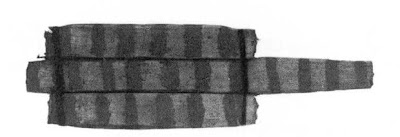Saturday, March 18, 2017
Random Boats of Chile and Peru
I'm able to respond in part to a recent request for information on boats of Chile, Argentina and Tierra del Fuego, based on my current reading of The Sea-Craft of Prehistory
Log rafts have been used all around the world and were probably among the earliest of all boat forms in most cultures. An odd feature is the near-universal use of an odd number of logs: 3, 5, 7 or more, and the common use of longer logs in the middle of the group. It seems as though the earliest boat builders were already envisioning the rudimentary boat shape, with a pointed bow, as shown in this pre-Columbian raft model found near Arica, Chile.

The model appears to be lashed together which, one would assume, replicated the original. Slightly more sophisticated raft construction involves pegging the logs together, sometimes boring a whole straight through all the logs at both ends and forcing poles through the holes to produce a more rigid structure than is possible by mere binding.
Keeping with the raft theme, here is a vessel built of two inflated sealskin pontoons, held together by a light cane framework and platform. Note how the narrow "bow" is formed by drawing the two pontoons together at their forward ends, allowing the aft ends to splay apart. The illustration was made in the early 19th century in Valparaiso, Chile, but similar rafts were observed as early as 1587 on the west coast of South America from 10 to 35 south latitude.

The Yahgan people of Tierra del Fuego were the southernmost population in the world at the time of European contact. They were known as the Canoe Indians, and their bark canoes were attractive and sophisticated -- more so than the bark canoes of Australia, but perhaps not as refined as those of North America. (The bark canoes of the nearby Alacaluf people, living on the Strait of Magellan in Chile, were similar.) These were big canoes, typically 24 to 26 feet, and occasionally more than 30.

Bark for these canoes was stripped from the tree using only sharpened flint tools. The bottom piece was laid on the ground with stones under the bow and stern and left for a few days to impart rocker, then side pieces were sewn on with reed stitching, straw and mud being used as caulking in the seams. Numerous bent frames were inserted, and the top ends were lashed to heavy gunwales, which were heat-bent previous to installation. A light framework was installed about 6" above the bottom and covered over with sticks laid crosswise to serve as decks fore and aft, the center area being left undecked for cargo, access for bailing, or both. Although the description quoted in Johnstone doesn't mention it, several thwarts were also installed. One would assume that these were purely structural and were not used as seats.
These canoes were typically paddled by women. The Yahgans adopted a rudimentary squaresail after European contact, setting up a temporary pole and yard forward and using a section of sealskin, held down in the hands at the lower corners, for downwind work.
Johnstone believed that the reed bundle raft may be as early as, if not earlier than, the log raft -- possibly the earliest of all boat types. In Peru, the caballito ("little horse") is a two-bundle reed float used to this day for shore fishing, although I suspect that tourism is more responsible for its persistence than any real economics of fishing. The paddler typically kneels in the cockpit, aft, and it is said that their surfing capabilities are impressive.

Subscribe to:
Post Comments (Atom)
No comments:
Post a Comment